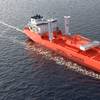Technical development in ships has been tremendous during the past 10 years. New technology has been introduced faster than ever before in the shipbuilding history. The new stricter rules have been the generator for many new solutions, but especially the total economical, conceptual approach has made it possible to introduce new systems, equipment and arrangements into a typically conservative market. Investments are considered on basis of lifetime cycle costs, but taking into account also possible additional revenues.
The issue is to maximize the efficient revenue generating space at minimized investment and running costs, but taking into account availability and environmental impacts as well. These items are to be clarified and their impact on the lifecycle economy of the vessel calculated before a decision can be made, (e.g. between different machinery configurations).
The tendency is clear and promising, new products and innovations are introduced and completely new machinery and ship configuration are developed for efficiency and economical reasons.
Considering cost efficiency we end up with four items: space, weight, power and equipment (materials). The efficient area and volume of the vessel compared with the total area and volume is a good indication of revenue generating capability and costs. Weight is directly related to building and fuel costs. Installed power onboard relates to the efficiency of hull, propulsion system and power generation. Equipment and materials are directly and indirectly, through required man-hours, cost related.
Space efficiency
Deltamarin has gathered and analyzed more than 50 recently built passenger cruise ships of all sizes. Rather big and sometimes amazing differences can be found in space utilization. Figures 1 and 2 present good examples.
Figure 1 (image16.gif) shows machinery space volume compared with the total volume of the ship. Smallest value is eight percent and highest 17.5 percent, the average being 11.3 percent, one exception being at 22 percent.
A further study of engine casing volume of selected vessels, figure 2 (image17.gif), shows the same kind of variation. Some of the differences can be explained by different vessel speeds, but for example both diesel electric and diesel mechanical types are included, and that gives no explanation, nor the year of build.
Bearing in mind that the machinery spaces and especially engine casing are located in the most centralized area of a vessel, it is certainly worth while considering carefully the efficiency and location of machinery spaces and casing.
Space efficiency can be considerably increased through clever machinery configuration selection and design. There are four different steps and selections to be considered:
-- power generation
-- propulsion system
-- machinery type
-- machinery location.
Electric power generation gives the freedom to select optimum power source and optimum number of power generating units. This leads to direct and indirect space savings.
Today the big challenge is the pod-propulsion. Pod-propulsion is an industry standard today in passenger cruise ships and has been applied also for product tankers (two refits), icebreakers and offshore vessels. Space saving is obvious, big propulsion motors are moved from the tank top outside the ship. Other benefits are potential for propulsion power savings, up to 15-20 percent, standardized, simplified hull forms, simple construction, installation man-hour savings, safer handling of the ship, etc.
The selection of machinery type has typically been between different types of diesels, but presently gas turbines have made their entrance into fast ferries and passenger cruise vessels, again with high space savings. In the new Panamax size RCI newbuildings, 'Vantage' and 'Millennium' class ships, it was possible to gain 50 additional passenger cabins by changing into combined gas and steam turbine electric machinery (COGES). Gas turbine machineries are now studied for all coming cruise ship projects but interestingly also for other types of commercial vessels, such as fast conventional ferries, RoRo ships, car carriers and even tankers. Space saving again playing a major role.
All aft machinery
Locating the machinery in the aftmost area of the vessel is normal and typical in many types of cargo vessels. The same philosophy, 'all aft machinery', we applied for a Panamax size 80,000 grt cruise vessel with a COGES plant together with pod propulsion, and reached 100 additional passenger cabins in comparison to conventional diesel-electric arrangement, see figure 3 (image18.gif). On top of the additional passenger revenue space, it was possible to completely rearrange and separate passenger, service and crew spaces avoiding mixed flows and gaining additional space efficiency. This arrangement was named 'all down service'. Thus, it was easy to guarantee also the additional service and public spaces for the increased passenger number and reach better well separated service functions.
Environmental Pressure
Fuel efficiency and exhaust gas emissions are directly linked. The lower the total fuel consumption at all operating modes with all the required functions onboard the lower the emissions. Pod propulsion has shown potential for vast power savings already in cruise ships.
When comparing exhaust emissions, it is essential to look not only at propulsion and service power generation but also fresh water generation, fuel heating and similar which typically require oil fired heaters and boilers, as well as other energy production which is connected to the main machinery. Table 1 shows a comparison of exhaust gas emissions for a Panamax cruise vessel in the Caribbean service between diesel-electric and COGES machineries. The total amount of fuel and lube oil burnt on an annual basis was close to 1,000 tons higher for the diesel configuration, mainly due to the boiler fuel required for fresh water production. Lube oil consumption was also higher for diesels whereas engine fuel consumption was higher for COGES plant.
Subscribe for
Maritime Reporter E-News
Maritime Reporter E-News is the maritime industry's largest circulation and most authoritative ENews Service, delivered to your Email five times per week









